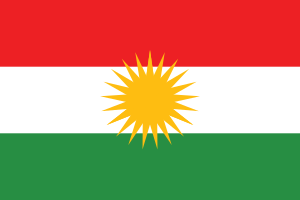Kurds in Kazakhstan
The Kurds in Kazakhstan form a part of the historically significant Kurdish population in the post-Soviet space, and encompass people born in or residing in Kazakhstan who are of Kurdish origin. According to the most recent Kazakh census in 2011, the Kurdish population is 38,325 or 0.2% of the population,[1] but Vice President of the Kurdish Association of Kazakhstan, Malikshah Gasanov numbers the population up to 46,000,[5] because many Kurds list themselves as Turks and Azeris.[3] During the Soviet era, most of the Kurdish population in the Kazakh SSR were deported there by Joseph Stalin from the Armenian, Azerbaijan and Georgian Soviet republics. Years later, Kurds immigrated to Kazakhstan from the neighbouring countries, Uzbekistan and Kyrgyzstan.[5]
| Total population | |
|---|---|
| 38,325 (0,2%) (2011 census)[1] 44,768 (2017 statistics)[2] | |
| Regions with significant populations | |
| Almaty Province, Jambyl Province, South Kazakhstan Province[3][4] | |
| Languages | |
| Kurdish (Kurmanji), Kazakh, Russian[3] | |
| Religion | |
| Overwhelmingly Islam | |
| Related ethnic groups | |
| Iranian people |
In cities with a substantial Kurdish population, Kurdish literature and Kurdish language is taught in the primary and secondary schools. In the village of Kashkabulak, Kurdish students can study Kurdish through 12th grade.[5] And since 1990, Kurds also have had their own newspaper, the Kurdistan newspaper.[5]
Religion among Kazakh Kurds[1]
Deportation and immigration
Kurds were deported twice to Central Asia from Caucasia. The first deportation occurred in 1937 where Stalin deported Kurds from Nakhchivan and the second deportation occurred in 1944 in Georgia. Stalin feared a Turkish invasion and he saw Kurds as unreliable, even though many Kurds served in the Soviet military. Many of them died during the deportations.[3]
After the Osh riots and the riots in Fergana Valley between Kyrgyzs and Uzbeks, many Kurds moved to Kazakhstan.[3]
Population by year
| Year | Population |
|---|---|
| 2011 | 38,325 |
| 2012 | 40,626 |
| 2013 | 41,431 |
| 2014 | 42,312 |
| 2015 | 43,119 |
| 2016 | 43,974 |
| 2017 | 44,768 |
See also
References
- "Table 4.1.1 Population by individual ethnic groups" (PDF). Government of Kazakhstan. stat.kz. Archived from the original (PDF) on February 28, 2013. Retrieved 9 July 2012.
- "Численность населения Республики Казахстан по отдельным этносам на начало 2017 года" (PDF).
- Ustina Markus; Didar Kassymova; Zhanat Kundakbayeva (2012). Historical Dictionary of Kazakhstan. p. 166. Retrieved 2 December 2012.
- People Without a Country: The Kurds and Kurdistan. p. 203. Retrieved 2 December 2012.
- "Kazakhstan: A paradise for ethnic minorities". Kurdish Media. Archived from the original on 25 March 2012. Retrieved 2 December 2012.
